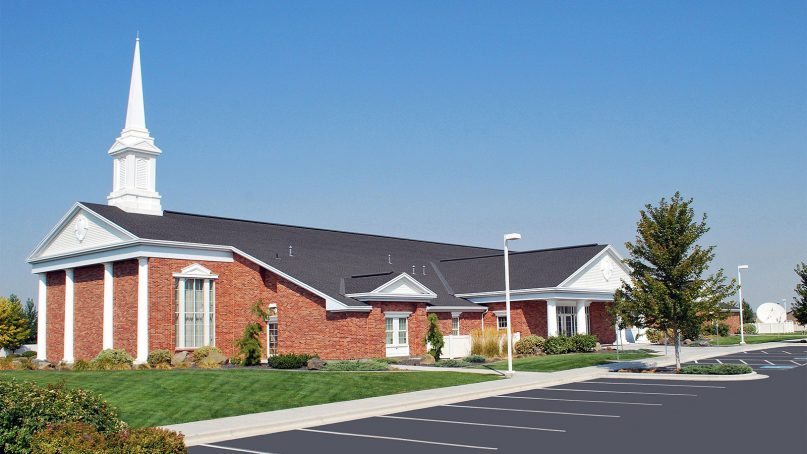(RNS) — A little press notice crossed my desk this week, announcing the Church of Jesus Christ of Latter-day Saints is starting a pilot program to allow LDS church buildings to be used as “gathering places” for young single adults.
Wonderful, I thought! It’s terrific the church is going to let them use chapels, Institute buildings and other church-owned structures to hang out. They need that: a relaxed, welcoming space where they can simply be together.
In my mind’s eye, I could imagine it. Maybe other people who are not Mormon will actually come, too, drawn in by the collegial atmosphere and possibly all the snacks. Mormons can’t hang out together without snacks.
Except then I read the fine print. The list of acceptable activities for the pilot program, according to the Church News, includes:
- Religious education and gospel learning (including institute)
- Service and social activities
- Temple and family history activities
- Self-reliance, education opportunities and support groups
- Missionary and community-outreach activities
- Other Church programs
So they can meet in the church building for … approved church meetings.
I’m scratching my head about what is on this list that young adults couldn’t do before. What is new here that warrants a “pilot test” in “a limited number of stakes”?
Because what it sounds like is, far from being able to use the church building for impromptu socializing, young adults will have to apply up the food chain for permission to use the building for approved activities, like conducting genealogy research, taking Institute classes and maybe doing a service project.
All of which are already available to them.
So, what the heck?
The article is clear everything has to be done with the approval of the area presidency and under the oversight of stake presidents and bishops. All according to the Handbook. And people should not go “implementing new initiatives” without first waiting to hear from the hierarchy whether their area has been chosen to participate in this select, special program.
In other words, don’t go crazy holding unauthorized religious education meetings, people! Things could get out of hand. People might think they can enjoy nondoctrinal fun together and play board games or something.

Young adults interact in Los Angeles, Calif. Photo by Alexis Brown/Creative Commons
Don’t get me wrong; I love that the church is reaching out to young adults and recognizing some of its old ways need to change. As I wrote recently, singles have the lowest activity rates of any demographic in the church, and if we’re truly interested in addressing that, it’s important some of these policies change to give them greater responsibility and freedom.
This is not the way to do that. The goal should be to allow them to make a home for themselves in a church that has been consciously and pointedly geared for married people. You do that by letting single adults actually be adults. Adults routinely gather together without chaperones, teachers, or ecclesiastical leaders present. They need only common interests, and maybe some brownies, and they’re good to go.
In the last few weeks, I have rediscovered some of my own favorite places to be an adult. Now that I’m fully vaccinated, it feels like the world is my oyster. So I’ve been hitting my favorite library, the coffeehouses where I often go to write, and my favorite local diners. One of these spots in particular is what sociologists would call my “third place” — some venue that is neither home nor work (your “first” and “second” places) where you feel totally yourself and find your community. Not to be too cheesy about it, but a third place feels like the theme song from Cheers. It’s the place you want to go because everybody knows your name.
For many Latter-day Saints, the ward building can feel like that place. But I would say it’s becoming rarer, because the ward just isn’t the center of community life the way it was a couple of generations ago. The goal of Correlation, especially since the early 1970s, was to bring all the church’s activities and curriculum under the umbrella of the priesthood. This means through the years there has been a systematic de-emphasis on — I’m just going to come out and say it — anything that existed purely for fun.
We don’t generally put on road shows anymore; we don’t hold Super Santa Saturdays; we don’t operate massive athletic leagues where young people compete against each other in sports. Gone are the days of Gold and Green balls and all-church dance festivals.
Of all the bygone activities that used to be part of church life, we still have firesides, because they are about teaching doctrine. Those are still around. Most of the others, the ones that existed for no other purpose but to build community through recreation, have gone by the wayside.
There are excellent reasons for this, since these activities depended on many hours of volunteer labor and were a ton of work. They were ridiculously inefficient, and Correlation has been all about efficiency.
I wonder, though: Can you build lasting community with efficiency as the primary model? Can you make people feel they’re at home in a safe “third place” when they have to get permission just to be in the building and are expected to spend all their time on religion?
I feel like this announcement of a pilot program about young adults being “allowed” to use the building is missing the point. If we want people to claim a space as their own and feel comfortable in it, we have to be willing to relinquish some control.
Are we?
Related content:
Finally! Single Mormons have new opportunities, greater respect
What the LDS Church wants to know from young adult Mormons






